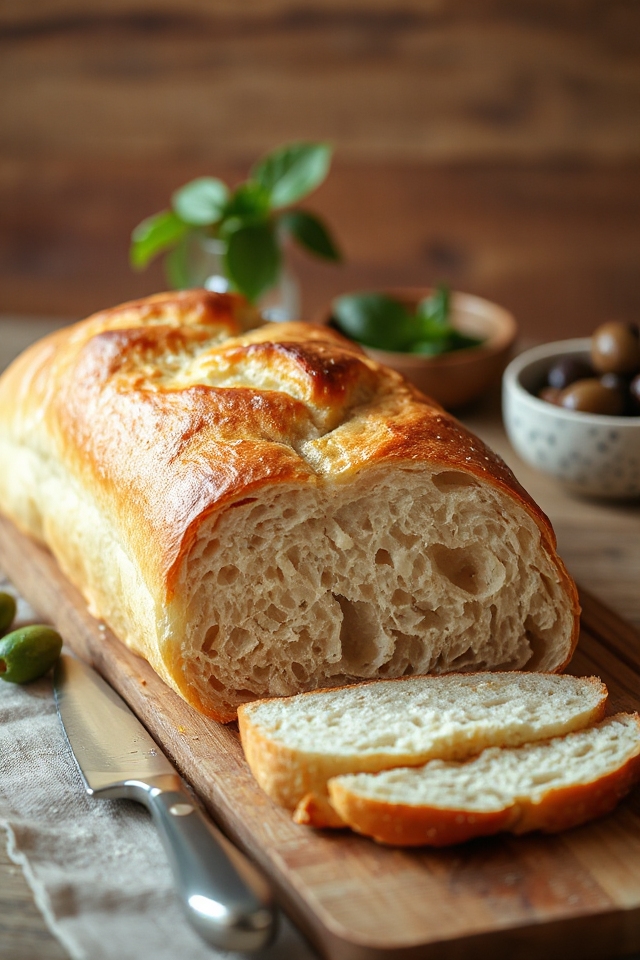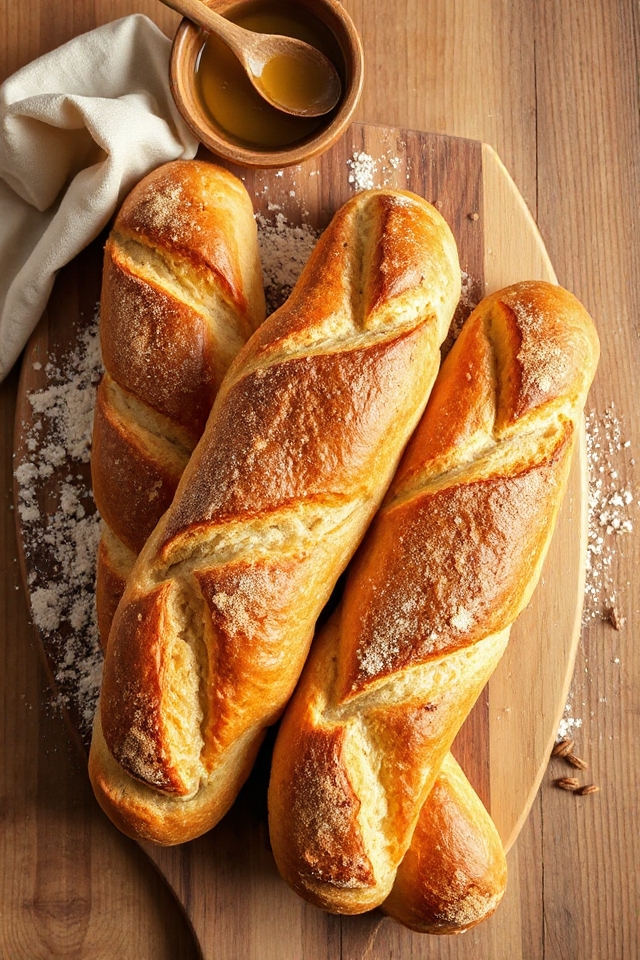Why You’ll Love This Easy French Bread Recipe
There’s something magical about the aroma of freshly baked bread wafting through your kitchen, and this Easy French Bread recipe captures that delight perfectly.
I love how simple it is—just a few ingredients and minimal effort yield incredible results. The crust turns golden brown, while the inside remains soft and airy.
It’s versatile, too; whether you’re slathering it with butter or using it for sandwiches, it never disappoints.
Plus, the satisfaction of pulling a loaf from the oven that you made yourself? Unbeatable.
Trust me, once you try this recipe, you’ll want to bake it again and again!
Ingredients of Easy French Bread
When it comes to making Easy French Bread, the ingredients are simple yet essential. You don’t need a lot of fancy stuff here—just some basic pantry staples. This is a recipe that welcomes both novice bakers and seasoned pros.
So, if you have a craving for that comforting scent of bread baking, let’s explore what you’ll need!
Ingredients:
- 6 – 7 cups all-purpose flour, divided
- 1 teaspoon sugar
- 1 teaspoon salt
- 1 tablespoon quick-rise instant yeast
- 3 tablespoons oil (preferably olive)
- 2 1/4 cups lukewarm water
Now, before you rush off to gather these ingredients, let’s chat about a few things.
First off, the flour is pretty important; it’s what gives your bread structure. You can use regular all-purpose flour, but if you’re feeling adventurous, try bread flour for a chewier texture.
And that yeast? Make sure it’s fresh, or you could end up with a loaf as flat as a pancake.
As for the oil, olive oil adds a lovely flavor, but feel free to substitute with any neutral oil if you’re in a pinch.
Remember, the quality of your ingredients can really shine through in the final product, so it’s worth it to use what you love.
Happy baking!
How to Make Easy French Bread

Alright, let’s explore the delightful world of making Easy French Bread. First things first, grab yourself a bowl and mix together 5 cups of all-purpose flour, 1 teaspoon of sugar, 1 teaspoon of salt, and 1 tablespoon of quick-rise instant yeast. This is where the magic begins—those ingredients are the backbone of your bread, so give them a good stir.
Once they’re all cozy together, it’s time to add 3 tablespoons of oil (I love using olive oil for that extra flavor) and 2 1/4 cups of lukewarm water. Now, here’s the fun part: use your hands or a sturdy spatula to mix until it all comes together. You’re looking for a shaggy dough that’s not too sticky but also not too dry.
When it reaches that perfect doughy texture, it’s time to get down to business and knead it. Lightly flour your surface and turn out the dough. Knead for about 6 to 8 minutes, adding more flour as needed until it becomes nice and elastic. Seriously, this is a workout, so don’t be surprised if your arms start feeling the burn.
Once you’ve kneaded it to perfection, let it rest for 10 minutes. This rest is essential, as it allows the gluten to relax a bit, making your bread easier to shape.
After the rest, divide the dough into three equal portions and roll each piece into a rectangle that’s about 14 inches long. Then, roll each rectangle up like a jelly roll, pinching those edges closed tightly—nobody wants a bread explosion in the oven.
Tuck the ends under, place them on greased baking sheets, and let them rise for an hour. While they’re puffing up, preheat your oven to 400°F and place a bowl of hot water on the bottom rack. This steam will help create that crusty outer layer we all love.
Bake those beauties for 15 minutes, then remove the bowl of water, reduce the temperature to 350°F, and let them bake for another 20 to 25 minutes. You’ll know they’re done when they’re golden brown and sound hollow when tapped.
Let them cool on racks, and just try to resist the urge to slice into them right away—it’s tough, I know. Enjoy that fresh-baked aroma filling your home.
Easy French Bread Substitutions & Variations
Exploring substitutions and variations for Easy French Bread can elevate your baking experience while catering to different tastes and dietary needs.
If you’re gluten-free, try using a gluten-free flour blend instead of all-purpose flour. For a richer flavor, consider adding herbs like rosemary or thyme into the dough.
If you want a slightly sweeter bread, you can increase the sugar or incorporate honey. You can also experiment with different oils, like avocado or coconut oil, for unique flavors.
Finally, try adding seeds like sesame or poppy on top before baking for a delightful crunch. Enjoy the creativity in your baking!
Additional Tips & Notes
After considering various substitutions and variations, it’s helpful to keep a few additional tips in mind for perfecting your Easy French Bread.
First, make sure your water is lukewarm, as too hot can kill the yeast. I like to use a kitchen scale for accurate flour measurements, ensuring my dough’s consistency.
If you want a crustier exterior, try scoring the loaves with a sharp knife before baking.
Finally, let the bread cool completely before slicing—it makes a big difference in texture.
Trust me, these little tips will elevate your homemade bread to a whole new level!
